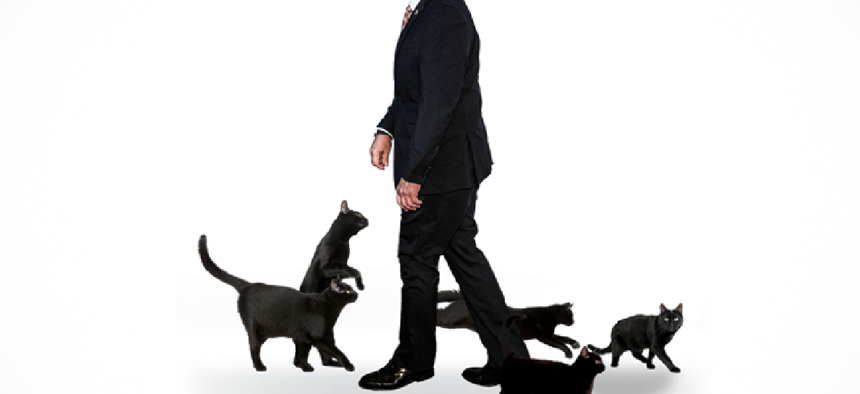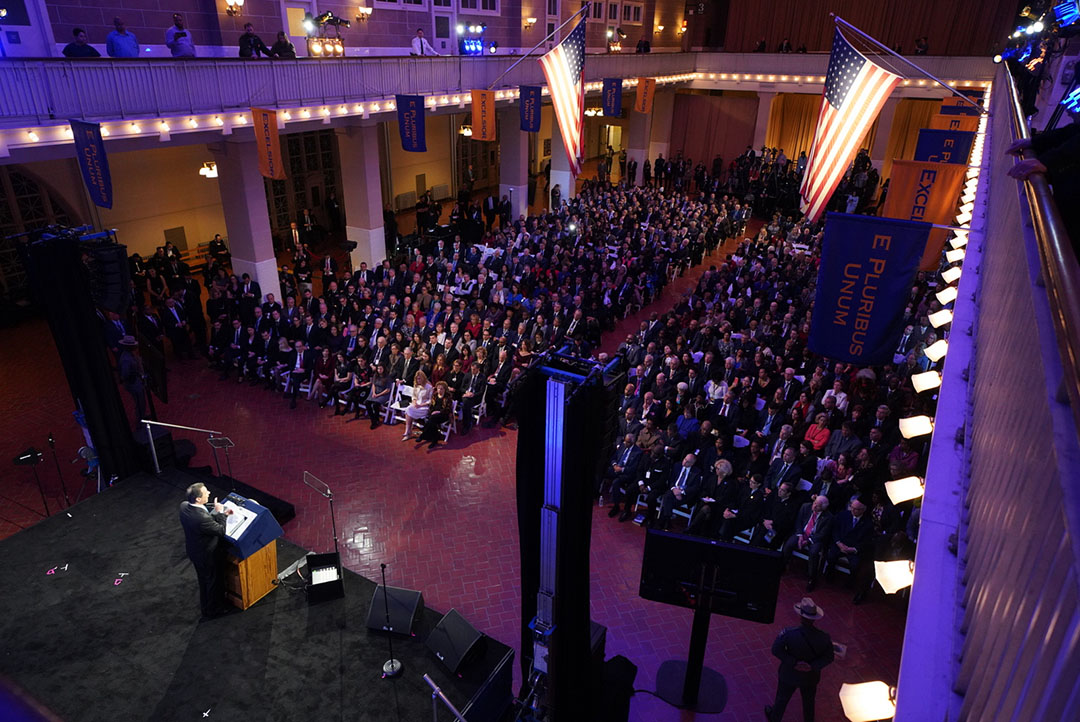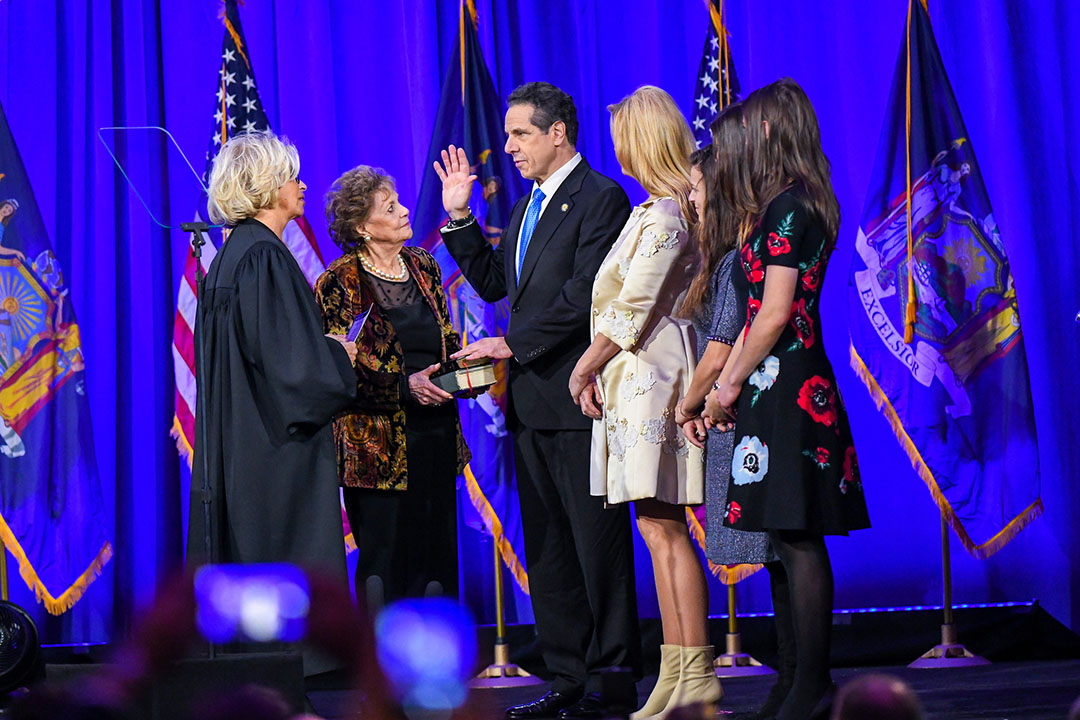Andrew Cuomo
Andrew Cuomo and the curse of the third term
Will single-party control allow the governor to avoid the pitfalls that plagued his long-serving predecessors?

andrew cuomo surrounded by black cats Photo illustration Alex Law; photos by Ron Adar, Eric Isselee, Tony Campbell, Fedotov Anatoly/Shutterstock
In an inauguration night rich with symbolism, Gov. Andrew Cuomo shipped his invitees across the dark, wind-whipped waters of New York Harbor past the Statue of Liberty’s torch. As if in steerage with standing room only, the huddled masses headed for the storied immigration waystation on Ellis Island. As guests shuffled across the swaying gangway toward the brilliantly lit historic hall on shore, the message was clear: Welcome to America.
The carefully constructed political theater projected the governor’s power on the national level, as a force for good opposing an ominous federal foe who manipulates and divides people. Inside the great upstairs hall, American flags outnumbered New York state flags and “E Pluribus Unum” banners were as numerous as “Excelsior” ones. “Like looters during a blackout, they didn’t cause the darkness, but they exploited it,” Cuomo said. “And this federal government has sought to demonize our differences and make our diversity our greatest weakness, rather than our greatest strength.”
Aside from the conspicuously presidential overtones at this gubernatorial inauguration – he denies he’s running in 2020 – Cuomo’s inaugural pageantry conveyed strength and a willingness to confront his ideological opponents.
With a Democratic sweep in 2018, Cuomo is empowered in his third term – a time often considered cursed, when popular politicians fade away or otherwise fail. But Cuomo’s uniquely strong position may have set him up to defy the third-term doldrums.
Cuomo cruised to re-election, easily dispatching his progressive challenger Cynthia Nixon in the Democratic primary and his Republican rival Marc Molinaro in the general election. Every statewide officer is now a Democrat and both the Assembly and state Senate are solidly blue.
Nevertheless, historians and veteran politicos say that third terms are never a charm. Past New York governors who had once been seen as rising national stars in their respective parties, such as Cuomo’s father, Mario Cuomo, and the elder Cuomo’s Republican successor, George Pataki, ended their third and final terms with their presidential prospects diminished. “The danger for any third-term executive,” said George Arzt, who served as third-term press secretary for then-New York City Mayor Ed Koch, “is a malaise that settles over the workforce, and you have to keep the workforce energized with new ideas, new projects, creativity, and it’s going to take a fierce leadership to do that.”
And while he begins his third term in a strong political position, Cuomo faces many stumbling blocks that have bedeviled past executives in their third terms – as well as unique challenges that could harm his coveted legacy as one of New York’s great governors.

Cuomo is set to preside over New York state with an immense partisan advantage. And in that respect, there’s little precedent for a third-term New York governor in his position. “Anyone who thinks this governor is slowing down doesn’t know Andrew Cuomo,” Secretary to the Governor Melissa DeRosa said. “He’s not capable of slowing down. He’s hard-wired to keep pushing the envelope.”
Many others City & State spoke to for this article agreed on that point, including New York’s only surviving three-term New York governor. “You keep your energy, at least from my experience,” said Pataki, who served from 1995 through 2006. But, he noted, “It’s easy to have your team run out of gas.”
Pataki said his best senior staff members were there in the first term and later left for other opportunities. Those who stayed on simply did not have the same fire by his third term.
“You have people in key positions who are good people, doing their best, but they’re just not able to achieve what you want them to achieve,” Pataki said.
While one Democratic lawmaker spoke approvingly of Cuomo’s existing senior staff – particularly DeRosa, Budget Director Robert Mujica and Counsel Alphonso David – the source said there is broad agreement that the whole team is not as strong as Cuomo’s incoming first-term team, and there is some concern over the possibility of losing anyone else in Cuomo’s tight orbit of aides.
Anyone who thinks this governor is slowing down doesn’t know Andrew Cuomo. He’s not capable of slowing down.” – Melissa DeRosa, secretary to the governor
Cuomo spokesman Richard Azzopardi rejected those claims. “That’s bullshit,” Azzopardi said. “This team is the one who made sure he got a clear mandate for a third term.” The current inner circle has been together for several years and helped pass a $15 minimum wage, paid family leave, new sexual harassment laws and free tuition at SUNY and CUNY colleges, he said. “We are battle tested and raring to go for the third term. That’s from the top on down.”
Yet Pataki cautioned that it can be a challenge for governors to keep their agenda fresh for a third term in office.“You’ve had eight years to achieve a great many things, so what do you do next?” the former governor asked. “But obviously, given Sept. 11, I never had that problem.”
If Pataki found himself preoccupied with abating a sudden humanitarian and economic catastrophe in the state, Cuomo has framed his third term as a bulwark against a political catastrophe in Washington, D.C., from the perspective of mostly liberal and heavily immigrant New York, and its consequences for New Yorkers. Cuomo has framed Trump’s policies as attacks on the state. During last year’s budget presentation, he called the Republican tax cut – which will actually raise taxes on many New Yorkers, despite a massive overall reduction in federal revenue – “an economic missile” that “says ‘New York’ on it.”
Against that backdrop, Cuomo has set out an ambitious agenda for his first 100 days that includes codifying Roe v. Wade into state law, expanding gun control laws, legalizing recreational marijuana, protecting organized labor, strengthening rent regulations and passing voting reforms, campaign finance reforms, criminal justice reforms and a “Green New Deal.” Democratic lawmakers note that many, if not all, of these initiatives were their priorities before the governor adopted them as his own.
With the state Senate Republicans, who Cuomo blamed for blocking liberal initiatives, removed from power, Cuomo and the state Legislature are largely on the same page for the first time in his tenure. So a host of accomplishments may pour forth in the legislative session.
The difficult part, said former senior Pataki aide David Catalfamo, comes later, when you face the diminished power of being a prospective lame duck. “There are different parts of the third term. When you’re first elected, you still got a lot of juice,” Catalfamo said. “But it’s really when you get into the second part of it, when people are trying to figure out if you’re going to run again, that affects your ability to deal with folks who think you won’t be around.”
Those folks are the 213 state legislators who will dictate how much Cuomo will ultimately accomplish in the coming years. Of all the hazards Albany power brokers past and present noted to City & State, several say the governor’s own hubris is perhaps the most dangerous. Legislators have complained of high-handed behavior from the governor, in which he thinks he can get away with making and breaking promises, such as when he vowed in 2010 to veto partisan redistricting but ultimately approved it.
Cuomo ... wears on people over time. In other words, people catch on to his bullshit.” – A Democratic lawmaker
After eight years in office, Cuomo has a track record of such behavior. Cuomo will need cooperation from some Democrats who feel that he has been an untrustworthy partner in the past. “The biggest reason the third term might be a challenge for (Cuomo) is he wears on people over time. In other words, people catch on to his bullshit,” said a Democratic lawmaker, who requested anonymity to speak candidly. “His strategy, and it works on the first couple of rounds, is that he lies to people and screws them. And once that’s happened to you a couple of times, you get wise to it.”
The governor’s office chafed at that characterization, arguing that what his critics call bullying is merely assertiveness: “It’s no secret that this is a hard-charging administration and we will continue to be a hard-charging administration,” Azzopardi said. “That’s what the people of New York demanded, that’s what the people of New York expect and that’s what we will keep on doing.”
Whether Cuomo is hubristic or merely hard-charging, he runs the common risk among third-term executives, such as former New York City Mayor Michael Bloomberg, of becoming imperious. There is already some tension between Cuomo and the state Legislature. Assembly Speaker Carl Heastie has openly chastised the governor for his attempts to limit lawmakers’ outside income. Neither Heastie nor state Senate Majority Leader Andrea Stewart-Cousins attended Cuomo’s inauguration.
“Those people who expect single-party control to be nirvana are way off base,” said Gerald Benjamin, director of the Benjamin Center at SUNY New Paltz. Beyond personality conflicts, Benjamin said, “They dismiss the idea of institutional conflict between the Legislature and the executive.”
Catalfamo agreed. “The institutional tension in Albany is not so much Democrat and Republican, it’s governor and Legislature,” the former Pataki aide said. “I walked out the door thinking, ‘Ah, this is great. I hope Eliot Spitzer kicks these guys’ ass.’”
In response to calls for renewed oversight of the Cuomo administration by the new heads of the Senate and Assembly investigation committees – state Sen. James Skoufis and Assemblyman Thomas Abinanti – the governor threatened an “investigations battle” in which he could examine lawmakers’ spending. “I’m hoping he’s not saying he’s bullying us,” Abinanti told City & State, explaining that the legislative push for robust oversight is simply a return to the branch’s duty to ensure good government. Cuomo insisted he wasn’t bullying lawmakers.
“If there’s discord,” Abinanti said, “it will be created by the governor.”
He added: “Now we have a united Legislature that will work together to make New York state government work for everyday New Yorkers. In the past, it was easy for him to divide and conquer.” Abinanti was referring to how the Independent Democratic Conference divided Senate Democrats and empowered Republicans for years. Since the election, however, the party is united across the Legislature, he said.
A pledge that Cuomo had Long Island Democratic candidates sign during the campaign first raised suspicions among some Democrats that Cuomo was trying to create another wedge similar to the now-defunct IDC – a so-called LIDC, or Long Island Democratic Conference. The governor’s office denied it. The pact vowed to make New York City pay its “fair share” of transit costs, an issue that could divide Democrats, although there is no indication such a faction has formed.
Other frequent third-term challenges have come from forces outside Albany, in particular a souring economy. As the stock market has repeatedly dipped in recent weeks, there is some concern that an economic downturn could hamstring any hopes for more expensive initiatives as it did in Mario Cuomo’s administration.
Pataki pointed out another area of long-standing concern that he believes could use improvement in Andrew Cuomo’s third term: the troubled economy of upstate New York. “We’re already losing population and the upstate economy is struggling horrifically,” Pataki said.
Defending the Cuomo administration, Azzopardi said that upstate population loss is a decadeslong issue, but that millennials are moving home and jobs are slowly growing. In regard to the troubled upstate economy, he said, “The policies of George Pataki did not help.”
Similarly, the rapid deterioration of the New York City subway system and the accompanying public outcry over mismanagement at the MTA could become a crippling political albatross for Cuomo if he doesn’t turn things around. While several political observers said his recent gambit to avoid a shutdown of the L train could be brilliant if it works out, he also has destroyed the illusion that he doesn’t control the agency – which he does.
“Obviously, you react to circumstances, but you shouldn’t let your agenda be driven by circumstances. You drive the agenda,” Pataki said. “You not only have to have a good team and an aggressive agenda, you also have to understand where things haven’t gone the way you like.”
Nowhere have things gone quite so wrong for Cuomo as they have on questions of ethics and corruption. As The New York Times’ grudging primary endorsement noted, the governor was elected on a promise to clean up Albany, but “instead of confronting the ethical horrors of the state capital, his administration has added to them.”
In recent months, people closely connected to Cuomo have been convicted of corruption. Joseph Percoco, who the governor called “my father’s third son” and was Andrew Cuomo’s most trusted aide, will serve six years in prison for bribery. Alain Kaloyeros was convicted and sentenced to more than three years in prison for rigging bids in the Buffalo Billion initiative to benefit the governor’s donors. Meanwhile, Dean Skelos and Sheldon Silver, the two powerful legislative leaders who Cuomo once jokingly lumped himself together with as “the three amigos,” are also likely headed to prison for corruption this year.
“The ethics in Albany are a disaster,” said Joseph Viteritti, chairman of the urban policy and planning department at Hunter College. “It will continue to sow deep suspicion as we go forward and more suspicion if people up there don’t take it on.”

After the inauguration, a former Mario Cuomo aide brushed off virtually all the above concerns about Andrew Cuomo’s third term, but, given the event’s national regalia, he noted the one threat to the governor’s third term he found the most serious. “If a leader flirts too much with higher office to create the expectation that he might be a candidate and then is not a candidate, I think that that psychologically takes the bloom off the rose,” said the source, who requested anonymity to speak frankly. “I’ve been there for that.”
The Albany press corps derided then-Gov. Mario Cuomo as “Hamlet on the Hudson” for publicly agonizing about whether to run for president in 1992. “That’s the only danger I see,” the former Mario Cuomo aide said of the younger Cuomo. “If he wants to run for president now, then God bless. But if he doesn’t, it’s a very fine line between making yourself more powerful and more prestigious by being a possible candidate or having people talk about your candidacy and then becoming yesterday’s news and losing power by not fulfilling that expectation.”
In 2015, Andrew Cuomo, who also served as his father’s political aide, wholeheartedly agreed with that notion. “The protracted expectation, the flirtation, is very harmful, because fundamentally what I have is my relationship with the people in the state. And they’re suspicious of my ego and my ambition,” Cuomo told The New Yorker. “There’s only one good way to deal with it: ‘I’m running for president, I’m telling you now, before you ask, that I’m running. Goodbye.’”
Others in the political class don’t see a downside to Cuomo’s coyness. “It’s a great manipulation. He can’t lose,” Arzt said. “You don’t say you’re running for president, you let the newspapers say you’re running for president.”
While America waits to see who will vie for the White House, skeptical legislative leaders in Albany appear to believe the governor most likely to deliver on Cuomo’s third-term agenda is the uniter Cuomo framed himself as in his third-term inauguration speech.
But taking his father’s onetime adviser’s warnings in another light, there is a fine line between raising hopes in the leader you promise to be and the political consequences of not fulfilling that promise. “The new Legislature will be working to ensure that the new Cuomo keeps the promises that he made,” Abinanti said. “I don’t think there has to be conflict. We should be on the same page.”

